Want an electric conversion? Be prepared to pay big money

About five years ago, I wrote a piece for Hagerty defending vintage car ownership. In it, I said that, on the surface, owning multiple vintage cars may seem as irresponsible as former first lady of Philippines Imelda Marcos owning thousands of pairs of shoes and hundreds of fur coats, but I defended myself and like-minded car nuts by arguing that, from an environmental standpoint, lightly driven vintage cars have a very small carbon footprint. I joked that my 1974 Lotus Europa, having been dead for 40 years, still owes the world a few decades of carbon.
Not long after, I began seeing articles about electric conversions of classic vehicles. There were press releases from both Aston Martin and Jaguar saying—in response to some European cities proposing the closure of their downtown sections to internal combustion vehicles—that they were offering well-heeled clients factory electric conversion of their precious E Types and DBwhatevers. Reading further, this allowed for cost-sharing of the new electric platforms being developed for Jaguar’s I-Pace crossover and Aston Martin’s Rapide E, so the motives were perhaps not as bright green as they seemed.
Aston Martin’s release really caught both my eye and my ridicule, as it referred to its electric conversion as a “cassette,” with the implication that it could be easily slid in and out. “The cassette system offers the perfect solution, offering owners the reassurance of knowing their car is future-proofed and socially responsible, yet still an authentic Aston Martin, with the ability to reinstate its original powertrain if desired.
OK. Well. First, “future-proofed?” Really? Is it going to automatically encase itself in carbonite like Han Solo when sea levels rise or if an asteroid pulverizes the planet?

Second, knowing nothing about electric conversion but a little about engine swaps, the idea that every aspect of a gas-to-electric conversion can be encased in a “cassette” may be good public relations, but it is of dubious engineering merit.
You might infer from this that I’m anti-EV. Not true. I think that electric vehicles, when recharged with power generated by renewable energy sources (e.g. solar and wind) are part of a necessary response to climate change. But I am resolutely anti-hyperbole.
Since then, the electric conversion of classic vehicles, or at least the aggressive marketing of it, appears to have only increased. Nowadays, it seems that you can’t throw a bad condenser without hitting a laptop displaying an article about electrifying classic cars. Shops performing conversion work appear to be springing up in many American cities. Some are single-marque or single-theme, while others are equal opportunity converters.
Normally I wouldn’t pay any of this much mind, but an electric-converted 1974 BMW 2002 recently went up for auction on Bring a Trailer. As I’ve owned 40 of these little German sedans and still own three of them, I couldn’t help having some academic interest. Plus, there’s the odd bit of historical trivia that BMW actually built two electric 2002s that were used during the 1972 Munich Olympics. With 12 Varta lead acid batteries under the hood, the cars had a range of 37 miles at a constant 31 mph. Fortunately, EV technology has advanced over the last 50 years.

The work on the BaT 2002 was performed by a shop in Austin, Texas, that has received favorable press. The company’s website and videos show converted high-dollar classics like an E Type, a long-hood 911, and an Alfa GT Veloce. The company owner and his engineers exude passion for the work and respect for the art form that is a vintage car, and they reason that electric conversion a) makes a car environmentally palatable, b) increases performance, and c) solves the problem of the unreliability of a 50-year-old internal combustion vehicle. If I can nitpick about that last point, in one video, one of the engineers perhaps drank from Aston Martin’s fountain, as he strays from passion to hyperbolae and says that classic cars “are fickle finicky vehicles, but when it’s [sic] run by a massive battery and an electric motor, it’s basically as reliable as a microwave oven.”
I’ve written multiple articles about what I refer to as “The Big Seven” things likely to strand a vintage car. They are ignition, fuel delivery, cooling, charging, belts, clutch hydraulics, and ball joints. I fully agree that if you replace an internal combustion engine and its cooling and charging systems with a modern electric system, you eliminate the first five of these, and that’s nothing to sneeze at. But you still have a classic vehicle with its attendant electrical quirks (funny, right?), old brakes, steering, and suspension, and now you’re adding in the range and “who repairs it?” issues of a one-off electric conversion whose battery capacity is unlike to be that of a ground-up design.
But even assuming there’s a step increase in reliability, there’s a huge overriding issue with these conversions. And it’s not the whole “you’re destroying a classic” argument. As far as I’m concerned, it’s your car—go to town and paint flaming purple Smurfs on the hood if you like. In the case of the BaT vehicle, a BMW 2002 is a common model. There are a lot of them. It’s not like someone is electrifying James Bond’s DB5 (and, even if they were, if you believe Aston Martin, you could always just hit the eject button and swap back in the internal combustion “cassette”).
Nor is it the “you’re destroying the classic’s soul” argument. There’s a whole continuum of paths for ownership of a classic car, from keeping it bone stock, to light modifications for drivability and reliability, to hot-rodded, to wild engine swaps, to turning it into track-only vehicle or a race car. Electrification is somewhere on the right edge of this curve.
Personally, I think if you want a newer, quieter, more-powerful car, you should just buy a newer, quieter, more-powerful car and stop trying to turn your classic into something it isn’t. But to single out electric conversion and point at it—Invasion-Of-The-Bodysnatchers-style—as an affront against man, and God, is silly. That being said, I do have some “soul” concerns. I’ve experienced how even mild modifications such as a stiffer suspension or a five-speed retrofit can change the car in unintended ways, affecting the way it sounds, feels, and vibrates. The relationships we have with our beloved cars are intimate things, and changes in a car’s vibe can affect our connection with it. Even over and above electrification’s obvious “no more gas, oil, and exhaust fumes” and “no more WAAAAAAAAAA-waaaaaaa when you wind it out” issues, I do wonder about the degree to which removing some of a car’s grit and rasp and replacing it with an antiseptic Stepford-wife, golf-cart whine may stress or break the owner-vehicle bond.
But the issue, the thing I’d like to see addressed in the first sentence of every article about electric conversion, is the high cost. The website of the company that converted the BMW 2002 on BaT estimates conversion cost at $50K–$150K, depending on the vehicle’s make and model, the need for general non-electric-conversion restoration work, the desired level of performance, and other factors.
Holy electrons, Batman. You’d have to leak a lot of gas, oil, and antifreeze to approach that.
It made me wonder who spends this kind of money. One of the company’s videos talks about people who “want the ability to appreciate that art form, but they want… a sense that they’re doing it with less impact to our planet” and “want the seamlessness of not worrying, just driving.” That’s great PR, but to me that price tag instantly makes this kind of conversion the province of folks with summer homes in the Hamptons.
My ever-reasonable wife asked me, “How does that compare with the cost of a new EV? Couldn’t a buyer be someone who simply wants a cool vintage electric-converted car to use as a daily driver?” Left-brained me answered that vintage vehicles and daily drivers are usually two different things, and that only a died-in-the-wool car person would likely put up with the wind and road noise, primitive suspension, reliability, and safety issues of a classic car, electrified or not, to try to daily it for anything other than trivially short commutes.
Let’s look at the specifics of the electric-converted 1974 BMW 2002 on BaT. What the car had going for it was that it was converted by a known company, the photos of the converted portions appeared to show excellent work, the car was painted the highly desirable color of Colorado (pale orange), and although it began life as a big-bumpered square tail light 2002, it had received a small-bumper conversion.
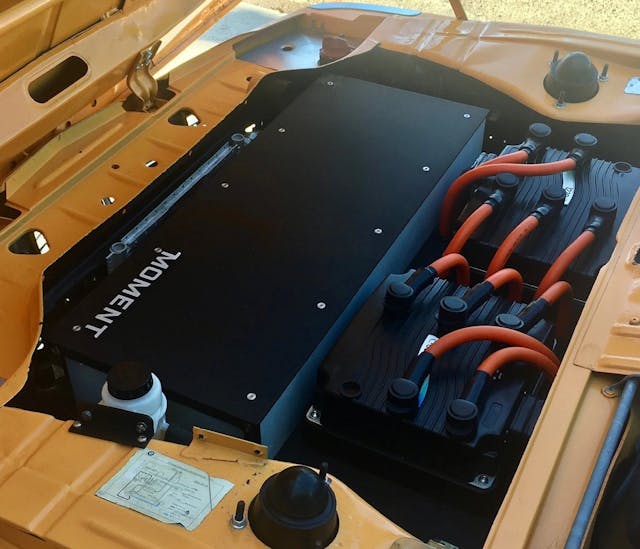
In addition, part of the converter’s design philosophy is to maintain the manual transmission and clutch, as that keeps the car fun to drive, and it doesn’t interfere with the look and feel of the gearshift lever. This car actually had a five-speed in it, which was pretty cool.
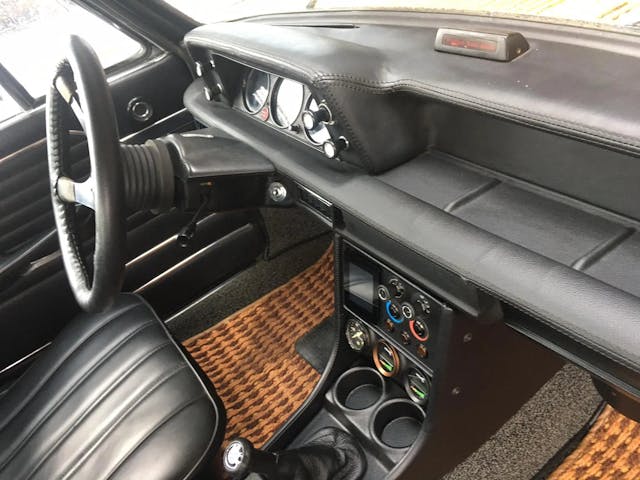
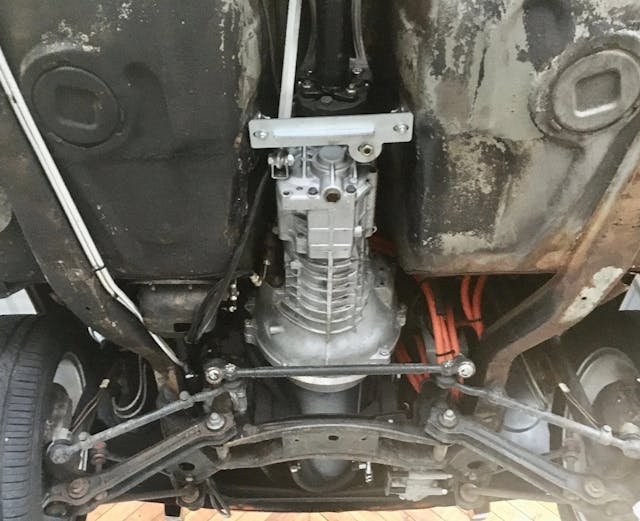
But there were some negatives. The rectangular holes for the original front bumpers’ hydraulic cylinders hadn’t been covered up; the car had been shaved (de-trimmed); it had air conditioning via a modern climate control box, whose vents were occupying the places in the dashboard where the original vent sliders were; and the dash had a stitched leather cover. OK, perhaps only the big bumper holes are a demerit, but while there’s nothing cringe-worthy with any of the other issues, there’s no denying that they collectively moved the car away from a bone-stock configuration. I’d think that from a value standpoint, a blue-chip electric-converted 2002 would be a flawless 1968–73 round-taillight car that looked absolutely stock until the hood was opened. This wasn’t that.
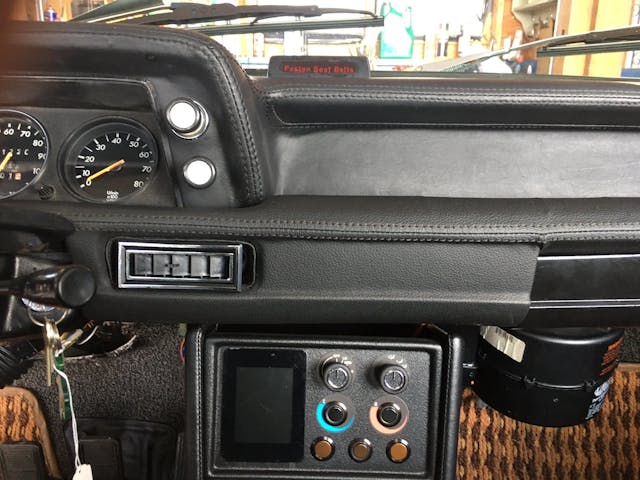

Plus, as pretty as the car’s exterior was, it had not had a rotisserie-style restoration, so the floor pans and subframes showed the small amounts of oxidation that every unrestored car has. Nothing wrong with that; every car I own looks likes this underneath. I imagined that the owner thought of the car as being in the Goldilocks zone for an electric conversion. That is, if it was too rare, too original, or too mint, you might not want to modify it, whereas if it was too beat-up or rusty, it wouldn’t be worth the expense and effort.
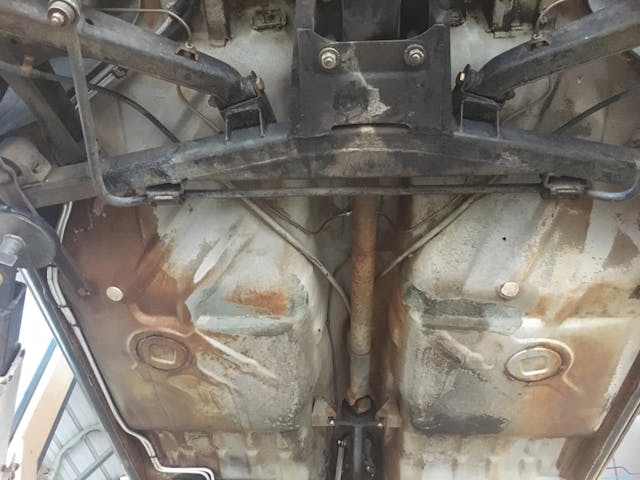
However, as I wrote when I tried to sell my 49,000-mile survivor 2002, what’s valued on BaT and causes bidding wars to head for the stratosphere are cars that present themselves in such a way that potential well-moneyed buyers think they’re bidding on a completed fully-executed whole that needs nothing. The contrast of a car’s freshly painted exterior with an original undercarriage conveys the image that the car is unfinished and holds the price on BaT down for any car. This was no exception.
The kicker was that although the car had a standard J1772 charging connector, and the conversion included a nifty adaptation of the stock gas gauge to display the reserve charge, the seller quoted the car’s range as only about a hundred miles. Gee, maybe things haven’t progressed as far as I would’ve thought since the 1972 Olympics.
Together, all these things added up to caveats that caused the bidding to top out at $42,500. Given the cost estimates listed on the conversion company’s website, I can’t imagine that the sale price wasn’t substantially less than the seller had in it.
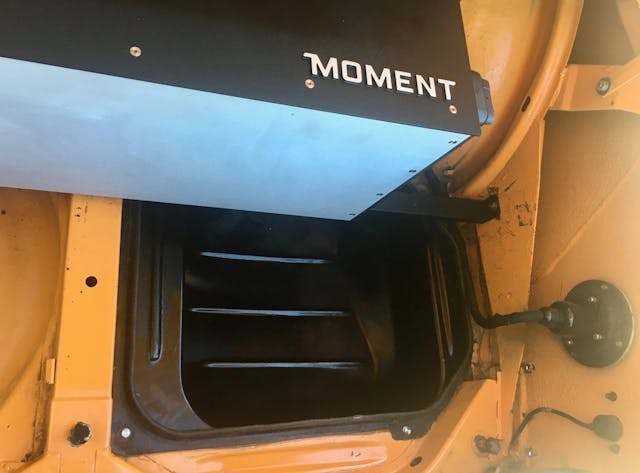
But still, $42,500 is a lot of money, at least it is to me, and that got me thinking.
As I say over and over, I am neither wealthy nor a collector. I own 13 vehicles (including a truck, little RV, and two daily drivers) because they’re either useful to me or they resonate with me in some way, but I struggle daily with both the financial and the storage repercussions. I see many cars locally on Craigslist and Facebook Marketplace that fall into what I think of as a “whim-able” price window. I used to regard this as four grand, in which all sorts of depreciated BMWs and running oddballs like Saab Sonnets, Fiat X1/9s, and ’63 Rambler 770s fall, but I’ve widened my view a bit to eight grand, as that also captures things like running but needy pre-1975 C3 Corvettes.
Still, in an environment of tightly-constrained money and space resources, the thought experiment I perform for any purchase—particularly one that’s outside my wheelhouse—is “What would I actually use the car for?” I know what I use the 1970s BMWs for. I road-trip the hell out of them. Yes, I also pleasure-drive them and use them to run errands—there’s nothing like taking a beloved classic to get milk on a Sunday morning to turn it into an event—but the road-trip part is in both my and the cars’ DNA. The Lotus Europa still hasn’t seen a big road trip, but I adore driving the featherweight little thing on twisty local roads. So, if the answer to the usage question is “I’d probably just drive it to cars and coffee a few times a year,” that’s a fail. I simply don’t have the space or the money to support owning something with that usage profile.
In truth, of course it’s less black and white than that. My 1999 BMW M Coupe (“the clown shoe”) is barely driven these days, and although my 49,000-mile 2002 did recently get a short road trip to Vermont, it’s more of an errand and a local events car. And some of my other ’70s BMWs haven’t seen a multi-day road trip in years.
But still, hypothetically, what would I actually use an electric 2002 (or any electrified classic whose range is only a hundred miles) for? That would seem to effectively rule out spirited day drives with my local 2002 pals. Yes, in theory, 30 minutes of a quick charger attached to the J1772 port should give an 80 percent charge, or another 80 miles, but that doesn’t feel like much. Me, I’d rather have the unconverted car with the range, the fumes, and the chunky rasp when I get on the throttle. And save the $42,500. Or the $50K–$150K, depending on how you want to look at it.
In my first book, there’s a chapter, titled “Restoration and why it makes no freaking sense,” in which I say that buying a car into which someone else has already sunk restoration money is almost always cheaper than spending the money yourself, but note how people pay to have cars restored anyway because it’s all about choice—what pops out at the end is the manifestation of all those choices, and so, naturally, you love it. I think that choosing to have a vintage vehicle electrified is a boutique subset of this larger restoration issue in that people who do it want to do it, probably because a) it fits their environmentally-friendly self-image, and b) they can afford it and the left-brain analytics probably don’t matter that much. I have no argument with that, but if you say that you’re doing it strictly for environmental reasons, and if your daily driver isn’t an EV, I think the justification is pretty thin. And if you say you’re doing it so you can still drive your beloved classic when gasoline is as controlled as ivory, okay, but you’re paying a very hefty premium to be on the bleeding edge. From this standpoint, the buyer of the electric 2002 on BaT made out very well.
So now I can tell you the surprising part: The BaT seller of the electric 2002 and the guy who paid to have the conversion work done was my old friend and BMW 2002 mentor from my days in Austin, Terry Sayther. Terry is 40-year member of the BMW Car Club of America, had a shop in Austin for decades, has forgotten more about 2002s than I’ll ever know, and has done a whole variety of engine swaps. In other words, the last thing he is is my hypothetical hedge-fund closet environmentalist EV-converted classic owner.
When I asked him why he did it, he said he wanted to experience an electric 2002 in the same way he wanted to experience a 2002 with a 240-horsepower S52 engine from an E36 M3 (which he also owns). He said that the electric 02 was very much a pleasure to drive, was a good city car (though more range would’ve been nice), was great to use on date nights with his wife, and, yes, did attract a lot of attention at cars and coffee events. So, you can ignore most everything I said.
Except the price tag.
If I’m still alive when gas really is akin to ivory, and the price of an electric conversion is comparable to that of an engine swap, I’ll likely change my tune (I’m above most things a practical man). Until then, you’ll recognize me because I’m the guy smiling as his car’s leaky fumy internal combustion engine is being wound out.
Really, I just want folks to be careful and realistic. The fact that an expensive boutique-converted electric BMW 2002 has only a hundred-mile range strikes me as a valuable illustration of where EV conversion technology is today and what is and isn’t reasonable to expect when you have to deal with the constraints of a vintage car. The time may come when electric conversion is the necessary and affordable way to keep driving your classic, but that time is certainly not today.
Oh, and that factory Jaguar electric E Type? Be careful what you wish for. This was the 2018 press photo of the dashboard in the prototype. If I ever owned an E Type, plunked down mortgage levels of money for electric conversion, and the interior came back looking like this, I’d want 10 minutes in a windowless room with the people who cashed my check.

***
Rob Siegel’s latest book, The Best of the Hack MechanicTM: 35 years of hacks, kluges, and assorted automotive mayhem, is available on Amazon. His other seven books are available here, or you can order personally inscribed copies through his website, www.robsiegel.com.


Look the whole point of the classic cars is to enjoy the past. Adding a EV kit would just bring a lot of issues and cost that I really don’t want.
First off my small mid engine car would be difficult to install a battery worth getting me anyplace. And then the weight would mess up the handling and make a 2500 pound car a mess.
I love the should and smell of the car and I can live with out on a daily car designed for it but not in my old car.
We as a group need to fight to protect our rights to preserve our classics ands the right to drive them. I understand where cooperate companies may be hesitant to support us as the Woke Community is a bit damaging but I wish more would stand up like those in the performance market.
I am not a EV fan but I fully understand they are coming like it or not. I am willing to be open minded to EV models designed to be EV. But to convert a ICE to gas is just making a mess of things.
They will never ban our cars but they will take the oils and gas we need to safely operate these models.
I would love to see Hagerty work to protect the classic cars you insure as if we can’t drive them it will impact business.
The RPM act to protect racing Via SEMA is only the first step we need a strong industry leader to help protect and lobby Washington to protect our cars and the items we need to drive them.
If you note many of the conversions are trucks as they use the bed and suspension to support the added weight and battery size.
Imagine a Lotus Else with a conversion. Where would the batteries go and just how large can you go. No much.
Don’t have to imagine. They did it back in the 90s. 200 hp, 120 mile range, less than 2000 lbs
https://www.chicagotribune.com/news/ct-xpm-1997-05-04-9705040192-story.html
And that is anything but a Lotus. Colin would have stopped this before it happened.
120 miles is use less. Even my 10 gallon tank will carry me 300 miles.
“Imagine a Lotus Else with a conversion. Where would the batteries go and just how large can you go. No much.”
I find humor in this comment since the first Tesla Roadster was based on an Elise chassis and one of the first Tesla prototypes, used for development work, was an actual Elise, one of the show cars from the US launch of the Elise.
100% agree that we need advocates on our side to push AGAINST this insanity. Fossil fuels are not going away, nor should they. They have been demonized for absolutely no reason. If we stopped the hot air coming out of this “movement”, we could probably save the planet from that alone.
I agree. One step further is that the time the planet had the highest CO2 it was during an Ice Age. I expect our environment to be free of pollutants and our water and air clean. But CO2 is not a pollutant nor can we say with 100% certainty fossil fuels can change the climate. All this talk of battery power to be the wave of the future is premature.
Unfortunately this “movement” will be with us for the rest of our lives. Fossil fuels will be banned yet the climate will continue on its merry way – proof to the zealots that we need to do more!
Wow, you are definitely living in the justify petroleum at any cost age! There needs to be a move away from toxic emissions at the very least. Trillions of gallons of petroleum are consumed every day with toxins being spread into the air, soil, and water. Electric and other methods of fueling vehicles have a long way to go and petroleum will bridge till it happens, but are you seriously not going to attempt to bring clean fuels to the table?
Since all the nuclear, solar at high noon on a clear day, and wind power at maximum combined doesn’t even come close to fulfilling base load needs, every time you charge your EV someone has to add another coal to the fire or other fossil fuel at the power plant. This nonsense is nothing more than limousine liberal virtue signaling and entrepreneurs willing to take their money in the process.
While I would never buy one of these Frankensteins, I firmly believe people should have the freedom to do what they want with their classic cars, which is not the case for owners of many historical homes.
an era is coming to an end as they all do;
ICE technology has run its course and that generation must come to grips with it;
i owned an E-type and a dozen Vettes up to today and i lament the passing of control the manual transmission gives but the instant and full torque batteries give obviates the need of winding up to it, if perhaps not the winding up and down through turns;
the energy source for ICE power is finite and the planet it’s drawn from fragile and subject to destruction from the by-products of ICE and the search and production of its fuel;
how much more plain need it be said..we are moving into the EV era, ICE romanticists…
Goodness, what would Elon Musk do if they handed him a Lotus Elise to do a EV conversion. It would probably look a lot like his 2008 Tesla Roadster, which looks a lot like a Lotus Elise.
That’s because it was a lotus Elise !!?
A car that AVERAGES 12 mpg will only go 120 miles on a tank that holds 10 gallons. My 1971 Camaro SS 350 averages about 12 mpg, so I can only go about 192 miles with its 16 gallon tank. Of course, it’s my fun car so the short range is not really an issue. My driving rewards are mental, not financial. The things we put up with for our “emotional support vehicles”.
To the comment moderator-
I posted a direct response to the posted comment “Imagine a Lotus Else with a conversion. Where would the batteries go and just how large can you go. No much.” and you chose not to publish it. Why?
Sir, you say: “They will never ban our cars but they will take the oils and gas we need to safely operate these models. ” However–the push to ban the use of Fossil Fuels for transportation certainly sounds like a ban to me. If you have studied the Agenda 21 (now 2030) Manifesto–private vehicles, other than bicycles and some small bikes and scooters and the like will be the only personal vehicles allowed. Otherwise. people will use ONLY Public Transport to and from anywhere–as interpreted by the Gov’t. So–let’s say you still own a classic ICE’d vehicle. How are you going to take it anywhere? How will you tow it to a show? When you learn how–tell the rest of us and show documentation signed by Agenda 21 World Proponents! Remember–the Gov’t owns everything and no private citizen can change Gov’t mandates.
Most commutes are less than 40 miles, but we don’t use classic cars to commute.
If you don’t do long trips with your vintage car than maybe an EV swap makes sense.
Would make more sense if the rebates went towards such retrofits instead of luxury cars rich people were going to buy anyways…
The GM e-crate engine concept holds some promise. But the costs have to come down. It also makes more sense to me to EV swap a vehicle that doesn’t have a functioning drivetrain (i.e., the old truck behind the barn) because then the cost comparison of either ICE or EV new drivetrain comes in.
Even if you used-scrounge it all and know what you are doing… not sure too many can do such a swap cheaper than calling a place like Summit Racing for an ICE crate engine and transmission though.
First if you want to do an EV conversion or want to purchase a new EV do it on your own dime. I shouldn’t have to subsidize your purchase with my tax dollars.
Second if you look at the physics behind battery powered EVs it is not currently environmentally friendly at all.
Most electricity is currently made by burning fossil fuel. By the time the electricity moves your vehicle down the road over 10 times more fossil fuel was burned to power the EV as opposed to an ICE vehicle.
But, but, but, the environment. We’re all going to die before my 55 Chevy reaches 80 in 2035. Woe is me. Putting in an electric motor in your classic is a slippery slope to banning the internal combustion engine in classic cars. A certain group ruins the fun out of everything they touch. No doubt, California will be the first to ban classics without electric motors. Hey all you guys with the Lowriders, you can probably use the hydraulics with more batteries to move your Chevys.
I saw a smart aleck sticker that said something to the effect of “If it’s really that amazing, then the marketing wouldn’t be needed”. It resonated
Not being cheap, but you can take that price tag for 100 miles of range and launch it up to where the greenhouse gasses hang out, sheesh. All my ICE vehicles are 500+ horsepower, and the mopars would not be mopars with a toaster for an “engine”.
Putting an electric motor in an E-Type – or any other classic for that matter – would be like putting a mustache on the Mona Lisa.
Leave it alone.
This is clearly a “to each his own” situation. Would I convert a 2002i to electric? Hell no. That’s a car well suited for spirited driving and have a 4 speed with an electric drive and 120 mile range is a total waste.
Now, how about a 67 Gran Prix convertible? I would say “Hell Yes!”. That would be a hella fun parade car and downtown cruiser. They never did handle great, got about 10 mpg on a good day and are absolutely massive. I’d probably just take a wrecked Model S for parts and build a chassis then drop the body on it. Or imagine doing that to really any old land yacht. (I just particularly like the looks of the 67 GP). The things were never good for handling, probably more fun as a passenger than as a driver, they were mainly about style and comfort. The other extreme are electric hotrods, but, to me, half the fun is the loud exhaust and smell of gasoline, though I’ll bet you could totally get tire melting launches and sub 10 second 1/4 miles, and still be able to cruise it in a civilized manner. But winding country roads in an EV? To me that’s a miss. I want to hear the revs and shift the gears.
There is a great eco compromise that is cheaper, reliable, and maintains original racket like engine noise, transmission whine etc. which we all love and that is propane. No more stale fuel worries, much cleaner combustion, no more leaky fuel pumps, easy fuel availability, reasonable mileage and range. Morgan was the only car company I know of who built propane vehicles in the early 1970’s to meet more stringent emissions standards with a minimum of all the Rube Goldberg mechanical issues.
Somebody converted my 1939 Dodge P/U to propane in the early 1980’s with a six cylinder flathead and it is reliable and fun. The fuel system is the same as is used on forklifts in enclosed warehouses, and the supply valve is more like a home furnace control than anything else.
Now I can hold my head high amongst the internal combustion naysayers by saying at least the truck is as clean running as most vehicles today!
Re: Morgan was the only car company I know of who built propane vehicles in the early 1970’s to meet more stringent emissions standards with a minimum of all the Rube Goldberg mechanical issues.
Bill Fink owner of Isis Imports developed, got EPA exemptions, etc. and did the Propane Conversions on Morgans in the 70’s to bring them back into the country, among a few other safety upgrades, he received the cars partially built for him to finish in his Pier 33 shop in SF. Then a few decades later, he did 13 of the Corvette transplants, etc. etc.
I’m in the luddite camp. I like old engines and old cars. I prefer the NVH characteristics of old cars, I love the sound of a healthy ICE. I don’t mind some oil leaks and fuel vapor smells. Points ignition is easy and reliable, a little preventative maintenance and time under the hood does a soul good. I don’t need all the nanny features telling me the tire pressure is low or my door isn’t closed all the way; no black box computers monitoring everything the vehicle does (and potentially reporting back to some manufacturer or gov’t!). Especially don’t need a vehicle that I have to wait over 1 hour to recharge, when a simple 5 minute gas stop does the same for my old ICE vintage vehicles. As the old joke, my car is a hybrid – burns gas and rubber!
I do not want a sanitized vintage vehicle that is too quiet and too modernized, with an EV conversion just to impress a bunch of green liberals that I do not want to hang out with. Those in agreement raise those greasy hands!
Agreed
Wait ten years until the battery dies and try to replace it. More $$$$$!
Right?
I’ve owned a 63 Valiant for 40 years and have only replaced one engine in it [and the only engine in any car] 34 years ago.
Inactivity , heat, cold, use, all chip away at battery life.
Even a beater will be able to get you somewhere. A “classic” or needing a battery pack won’t even get you to cars n’ coffee without a tow truck.
Sounds like the fastest way to ruin the fun of any car.
I really think we need to stop with this nonsense. Whether or not EVs are coming to the market mainstream (we are still not there and are a VERY LONG way off from having the infrastructure to support the ridiculous notion that everyone needs an electric car charged off a grid run by natural gas, coal, or nuclear energy), the simple fact is that “climate change” has NO PLACE on this website or any site devoted to classic motoring. It’s just that…CLASSIC motoring…the smells, leaks, fuel consumption, and utter enjoyment of driving something made ages ago that we can no longer get. Why are we converting these treasures to modern piles of soul-less garbage.
Please stop trying to force political hack discussions on classic car owners. We come here for way different reasons than to hear the usual drivel force fed to us by other forms of “media”.
Other than that, I have no issues with this idea 😛
Simply put, you will NEVER see an electric motor in my numbers matching Plymouth Superbird or any of my other old cars for that matter No apologies. Ever.
Article rambled on and on should have been condensed down to half the gibberish, skipped most of it as I thought it would lead to other car conversions, bad article!
Every classic car is a money pit.
I am a practical individual as well. I drove my classic about 200 miles last season. I am unsure how much of a carbon footprint that is but I am not going out on a limb too far when I guess its very little. I did it because I like the sound the smell and the experience. If I were to do an e-conversion, would it save a lot in terms of carbon footprint after we factor in the manufacturing of the batteries that incorporate the mining, disposal and manufacturing. Let’s think, how was the electricity produced? Was it with diesel, coal, nuclear, possibly wind, hydro dam? how was it delivered? It’s not a 100% savings in carbon regardless of what colour your favourite cool-aid is. Oh yes, why did I drive the classic? The experience, the smell, the noise, the excitement. It seems very sterile without all that. I don’t think I want a spruce that takes batteries or an air-pump, whom I can see in a pristine white room with no windows or sound. From my cold, dead hands comes to mind. Yes, the day is coming. Artificial ICE noises through a speaker to make the driver feel happier? Was that in a pristine white room with no windows?
The irony of an EV-converted classic is that the carbon footprint of the new EV drivetrain FAR exceeds the existing one. With the typical sporadic usage of a collector car, it would take hundreds of years of ICE driving your classic to equal the damage done to the planet from just the production of the EV system… now factor in a new battery bank every decade or so and you’ll always be in the red environmentally.
The most sustainable vehicle you can have is the one you already own. Full stop.